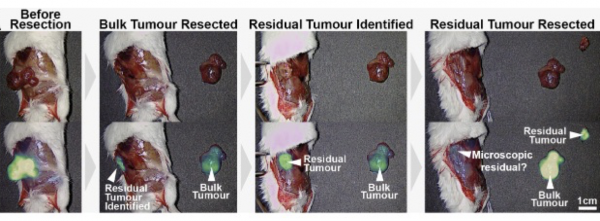Metal-based Photoimmunotherapy Agents for the Targeted Treatment of Neuroblastoma
Primary supervisor: Adam Sedgwick, King’s College London
Secondary supervisor: Jeannine Hess, The Francis Crick Institute
Tertiary supervisor: Stefano Giuliani, UCL
Project
Project background and description: Neuroblastoma is the most common extracranial solid tumour in children, and complete surgical resection is crucial for survival [1]. However, these tumours often encase blood vessels, nerves, and are adherent to major organs, making surgical resection extremely challenging. As a result, to avoid major complications, residual tumour tissue is often left behind. To date, no intraoperative treatments exist that would eliminate the remaining unresectable tumour tissue. Dr Giuliani developed a targeted fluorescence-guided surgery (FGS) probe for neuroblastoma by conjugating an anti-GD2 monoclonal antibody (Dinituximab-beta) to the commercially available near-infrared fluorescent dye, IRDye800 [2]. The antibody-fluorophore conjugate (anti–GD2-IR800) effectively targeted the tumour, enabling its visualisation and precise removal (Figure 1). Here, we propose to build on this targeted approach by developing an “all-in-one” theranostic platform to (1) enable visualisation of the solid tumour by fluorescence, and (2) to effectively clear residual tumour tissue of high-risk neuroblastoma via photoimmunotherapy.
Photodynamic therapy (PDT) represents a clinically viable therapeutic modality in surgical oncology [3]. The technique uses light to activate a photosensitiser to produce cytotoxic reactive oxygen species (ROS), that selectively eliminate tumour cells. Photosensitisers are inherently fluorescent enabling simultaneous visualisation for integration with FGS. The combination of PDT and immunotherapy (photoimmunotherapy) through the design of antibody-photosensitiser conjugates is rapidly emerging as a promising clinical approach for treating inoperable tumours. By targeting cancer-specific receptors, antibodies enhance tumour cell selectivity of the photosensitiser while inducing a unique combined photo-induced anti-tumour immune response. Clinical studies have demonstrated the success of photoimmunotherapy across several cancers. Compared to traditional PDT agents, metal-based photosensitisers possess unique advantages with the potential to transverse across the clinical landscape from nuclear medicine to FGS [4]. Nuclear imaging will ensure sufficient localisation of the antibody-photosensitiser conjugates prior to surgery. In this project, we will synthesis metal-based PDT scaffolds5 (Figure 1B) as potential metal-based antibody-photosensitiser conjugates.
The student will be a part of a multidisciplinary team comprising of Chemistry (Dr Adam Sedgwick), Photodynamic therapy (Dr Jeannine Hess), Radiochemistry (Dr Cinzia Imberti) and Fluorescence guided surgery (Dr Stefano Giuliani), all of which will ensure the success of the proposed project.
Year 1 – Synthesise photosensitisers and conjugates to evaluate their dark and light-dependent toxicity. Training in cell culture techniques and development of assays. Feedback loop between synthesis and cell culture enabling further structure-activity relationship (SAR) studies.
Year 2 – The optimised conjugates developed in year 1 will be studied via fluorescence microscopy of cells and tumour spheroids to confirm the cancer specificity of this strategy. Data obtained will be used for further synthetic optimisation.
Year 3 – Cell viability assays will be conducted in both 2D and 3D culture systems under light-exposed and dark conditions. Additionally, the student will perform radiochemistry experiments to synthesize nuclear imaging analogues.
Year 4 – In vitro and in vivo parameters (e.g. PK, ADMET) will be optimised to understand dosing and time points, which will be determined by fluorescence and nuclear imaging.

Candidate background
Experience in synthetic chemistry and a strong interest in chemical biology and drug discovery is desired.
Potential Research Placements
- Jeannine Hess, The Francis Crick Institute
- Stefano Giuliani, Great Ormond Street Hospital – Zayed Centre for Research, UCL
- Cinzia Imberti, St Thomas’ Hospital, King’s College London
References
- F. Fati, R. Pulvirenti, I. Paraboschi and G. Martucciello, Children (Basel), 2021, 8. 446; https://doi.org/10.3390/children8060446
- L. Privitera, D. J. Waterhouse, A. Preziosi, I. Paraboschi, O. Ogunlade, C. Da Pieve, M. Barisa, O. Ogunbiyi, G. Weitsman, J. C. Hutchinson, K. Cross, L. Biassoni, D. Stoyanov, N. Sebire, P. Beard, P. De Coppi, G. Kramer-Marek, J. Anderson and S. Giuliani, Cancer Res, 2023, 83, 2077-2089.
- D. Aebisher, K. Rogóż, A. Myśliwiec, K. Dynarowicz, R. Wiench, G. Cieślar, A. Kawczyk-Krupka and D. Bartusik-Aebisher, Frontiers in Oncology, 2024, 14. DOI:10.3389/fonc.2024.1373263
- Z.-S. Yang, Y. Yao, A. C. Sedgwick, C. Li, Y. Xia, Y. Wang, L. Kang, H. Su, B.-W. Wang, S. Gao, J. L. Sessler and J.-L. Zhang, Chem. Sci., 2020, 11, 8204-8213.
- J. Hess, H. Huang, A. Kaiser, V. Pierroz, O. Blacque, H. Chao and G. Gasser, Chem. Eur. J., 2017, 23, 9888-9896.
